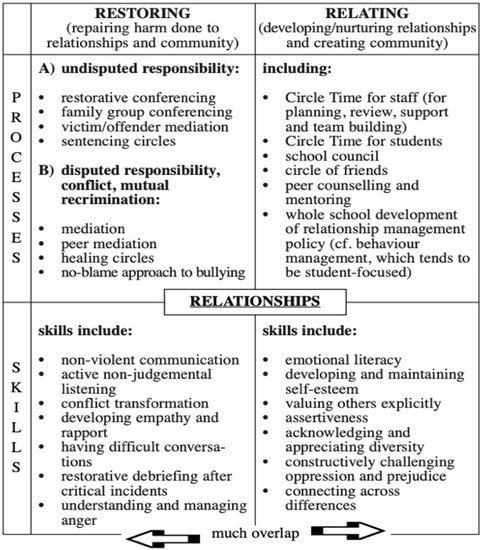The use of restorative justice (RJ) and restorative practices (RP) in schools has grown rapidly. RP can improve the school climate, discipline, positive conflict management through actions that aim at preventing suspensions, exclusions, conflicts, and misbehaviours (e.g., bullying). RJ practices promote positive relationships between peers and between students and teachers, as well as to prosocial behaviours through the development of social and emotional skills.
- school
- restorative justice
- restorative practices
1. Introduction
2. Restorative Justice and Restorative Practices
3. Restorative Justice and Restorative Practices at School

4. Restorative Justice and Restorative Practices at School
Some schools have promoted the implementation of restorative justice as a whole school-oriented approach in order to change the school and the disciplinary policy that had characterized the schools up to that time, such as traditional approaches and zero-tolerance policies. In this sense, several reflections on punitive and exclusionary school disciplinary policies have emerged, defining them as a matter of health justice and underlining the importance of implementing alternative disciplinary practices, such as restorative justice practices. Traditional approaches and/or zero-tolerance policies very often exaggerate the inequalities of treatment of students of different races, gender, socioeconomic status and increase the likelihood of recurrence of deviant behaviours and criminal behaviours, as well as school dropout. These modalities involve actions of exclusion that lead to stigmatization even more, distancing, and isolation of young people from the school context and from people in general, increasing fragility and vulnerability even more.
Very often, some schools have activated restorative justice practices, including via involvement of external experts, to respond to cases of serious conflict and violence, as well as in cases of bullying, as restorative practices promote active involvement in the processes of solving a bully/victim problem [57]. Sometimes, conflicts are an integral part of community life, such as school, and can represent valid opportunities for growth, but very often the inability to manage and face them or manage them and deal with them with punitive practices leads to an opposite effect. However, it is fundamental to promote alternative and nonviolent methods that can favour the possibility for people to confront each other with respect to different opinions, beliefs, and values as well as have greater awareness of the situation and work together to find solutions. Restorative processes can be a nonviolent response: they help to prevent and reduce conflicts and resolve them peacefully [58]. The potential of interventions and/or restorative programs was highlighted with respect to a greater ability to manage and respond to behavioural problems. Therefore, schools that implement the restorative approach and practices achieve improvements in school discipline, reduction in injuries, disciplinary postponements, and school offenses. Consequently, there are greater positive behaviours and lower suspension rates and disciplinary sanctions, less need for punitive measures. Indeed, interventions and restorative justice projects at the whole school lead to the promotion of alternative and multilevel methods of managing behavioural problems [59].
Restorative practices not only represent alternative practices to managing and responding to incorrect and violent behaviours (e.g., bullying and school crimes), but also significant spaces and opportunities to tell one’s opinions and emotions, lower the level of disciplinary disparity between students of different races, cultures, and gender, proactively participate in decision-making processes. In addition, some studies showed better academic performance, resulting in lower levels of absenteeism. In this sense, in line with the academic scientific literature, in schools that have implemented restorative justice and restorative practices, there is a slight increase in the average grade, an increase in graduation rates, and a more than double decrease in dropout rates [60]. Therefore, the implementation of the restorative approach and restorative practices is expressed not only as a response to conflict, but in a preventive key to welcome and care for people, relationships, communities.
Furthermore, the restorative approach allows promoting prosocial behaviours through the development of social and emotional skills (e.g., responsibility), listening skills, and peaceful conflict resolution, positive interpersonal relationships, and trust, greater collaboration between school, police, justice system, families. This approach, by changing the entire school environment, could be one of the most effective and efficient ways to build safe, equitable, and inclusive school communities that promote empowerment, well-being, and better quality of life of all members. In addition, the restorative approach can contribute to a significant reduction in school exclusion and inequalities of gender, race, and socioeconomic status [61]. In this perspective, a more general focus can be found in the use of the restorative approach for the management and promotion of interpersonal relationships: positive relationships in the school context (with parents, teachers, peers) are associated with positive outcomes in many spheres of children’s and adolescents’ individual and educational development, affecting school engagement, achievement, and well-being [62]. Scientific research on youth well-being adopts perspectives that aim at improving the quality of life of people, with a specific focus on those protective factors at an individual and contextual level (for example, positive school adaptation) that can promote well-being and/or favour factors and behaviours harmful to health [63,64]. It is also a social level issue “since understanding adolescents’ needs related to mental health is a basilar issue to let young people not only to fulfil their potential but also to contribute to the development of our communities” [63] (p. 125). For this reason, the effects of restorative justice and restorative practices on the management and containment of health risk behaviours should also be emphasized. Therefore, it was found that the use of the restorative approach at school reduces the likelihood of students engaging in harmful behaviours for health such as the use of substances, such as alcohol and drugs, smoking, and dangerous sexual relations.
This entry is adapted from the peer-reviewed paper 10.3390/ijerph19010096
 Encyclopedia
Encyclopedia
